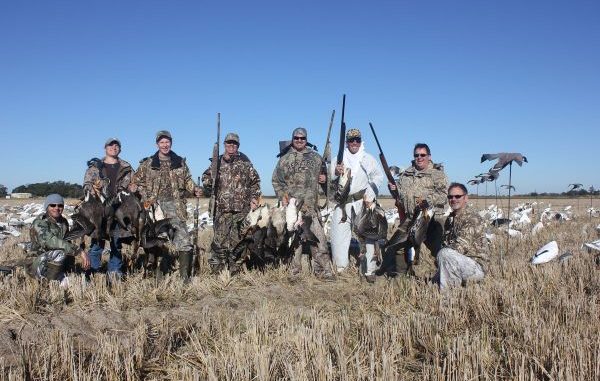
1) Finding the flyways
It might sound basic, but without geese hunting is impossible.
“To have a chance at killing geese, you have to be on a flyway,” Matthew said. “Geese use the same flyways based on food and water sources available.
“It takes at least one season to find these flyways, and you have to do it by observation.”
He advised goose hunters to find fields where the geese are feeding and resting, and establish the flyways they are using to move between the fields they are using.
Once you find these flyways, the geese tend to use them day after day and year after year.
2) Selecting the right field
Once the flyways are located, the next step is to select a field and secure permission to hunt in or lease, Matthew said.
Then it’s just a matter of setting up a convincing spread.
“What you are trying to imitate is a large body of geese on the ground and attract geese overhead to your spread,” Matthew said.
Some fields are better than others, though. Matthew prefers to hunt a dry rice stubble field.
“I like rice stubble because the stubble creates a little higher profile for the hunters to hide in, and the stubble holds the rags up nicely and makes them look more lifelike,” he said.
Late in the season, however, Matthew might move to rye grass fields.
3) Rag spread strategies
How many decoys should you have for a rag spread? That’s easy, Matthew said.
“You should put out as many as you can handle,” he said. “You can’t have too many.”
Matthew’s rag spreads are huge, including as many as 4,000 decoys.
It normally takes at least four guides up to three hours to deploy a spread consisting of just about every type of goose decoy made.
The majority of the spread is made up of goose rags in order to provide critical mass, Matthew said.
Wind socks are used to give movement to the spread.
Silhouettes add some height to the spread, and full-body dekes and shells are placed in the front and center of the spread so geese will see the best decoys as they approach.
Matthew also uses some landing decoys and flapping wings to provide additional movement.
When the spread is complete, it is a work of art.
The main body of decoys is normally set in an L or U configuration. He also sets several smaller clusters of geese away from the main body to imitate groups that have broken off and are feeding on their own.
4) Calling
Matthew uses several different calls and calling techniques to lure geese into his spread. He said calling is essential, and to be successful you must imitate the exact sounds geese make when they are relaxed and in their natural setting.
“One of the best ways to learn how to sound like geese is to find a large flock feeding or resting in a field and try to get within hearing range of them, and just sit and listen to what sounds they make,” he said. “Key in on a few basic sounds and try to imitate those sounds with your calls or mouth.”
Matthew uses a custom-made speck call, Canada goose calls and his mouth to call blues and snows.
He believes getting a two-way conversation going with the geese is essential — that is, letting geese call back to the callers who then answer the birds.
Matthew is a believer in soft and subtle calling and, in most situations, he does not call very aggressively to keep things as natural as possible.
5) Weather
As with all waterfowling, goose hunting is highly dependent on weather conditions, but Matthew believes the single most-important weather factor is wind.
The direction of the wind is not as important as the velocity; he likes the wind to be between 10 and 15 mph to get the spread moving.
Temperature is not critical, but clear conditions are best to allow for better visibility by overhead geese so they can see the rag spread from greater distances and come down for a closer look.